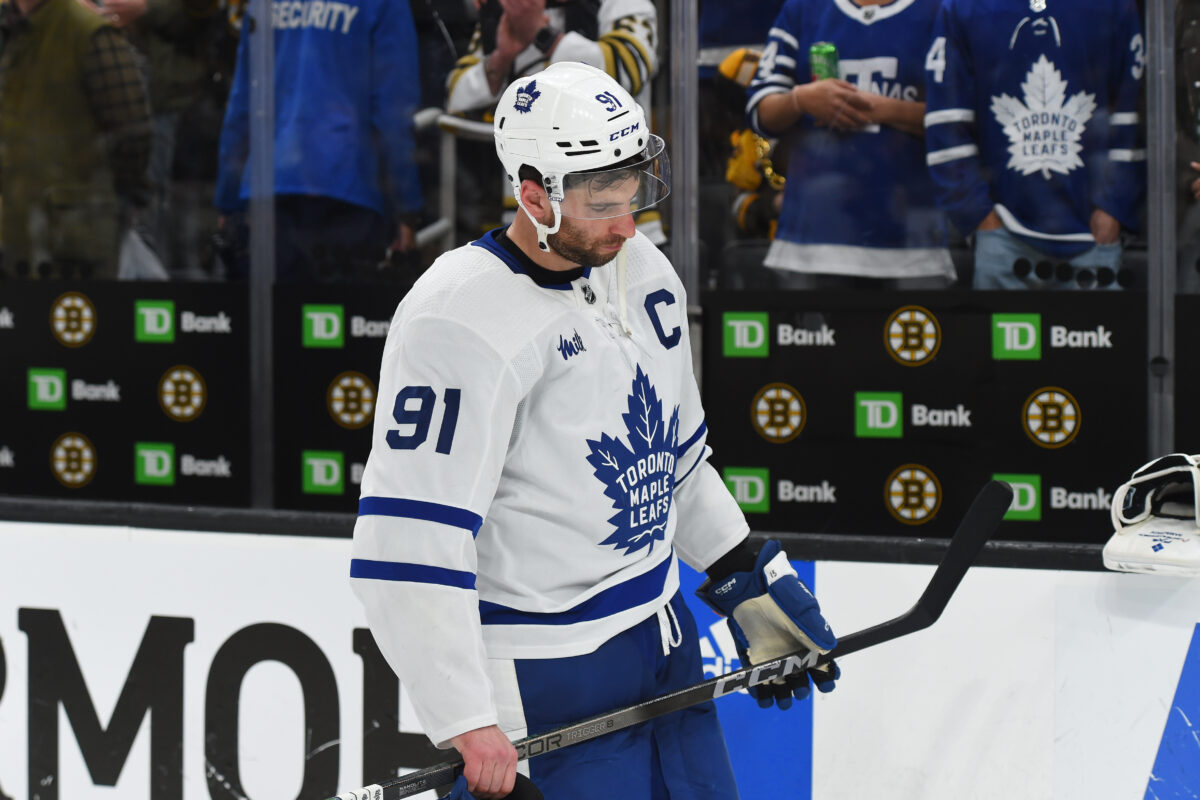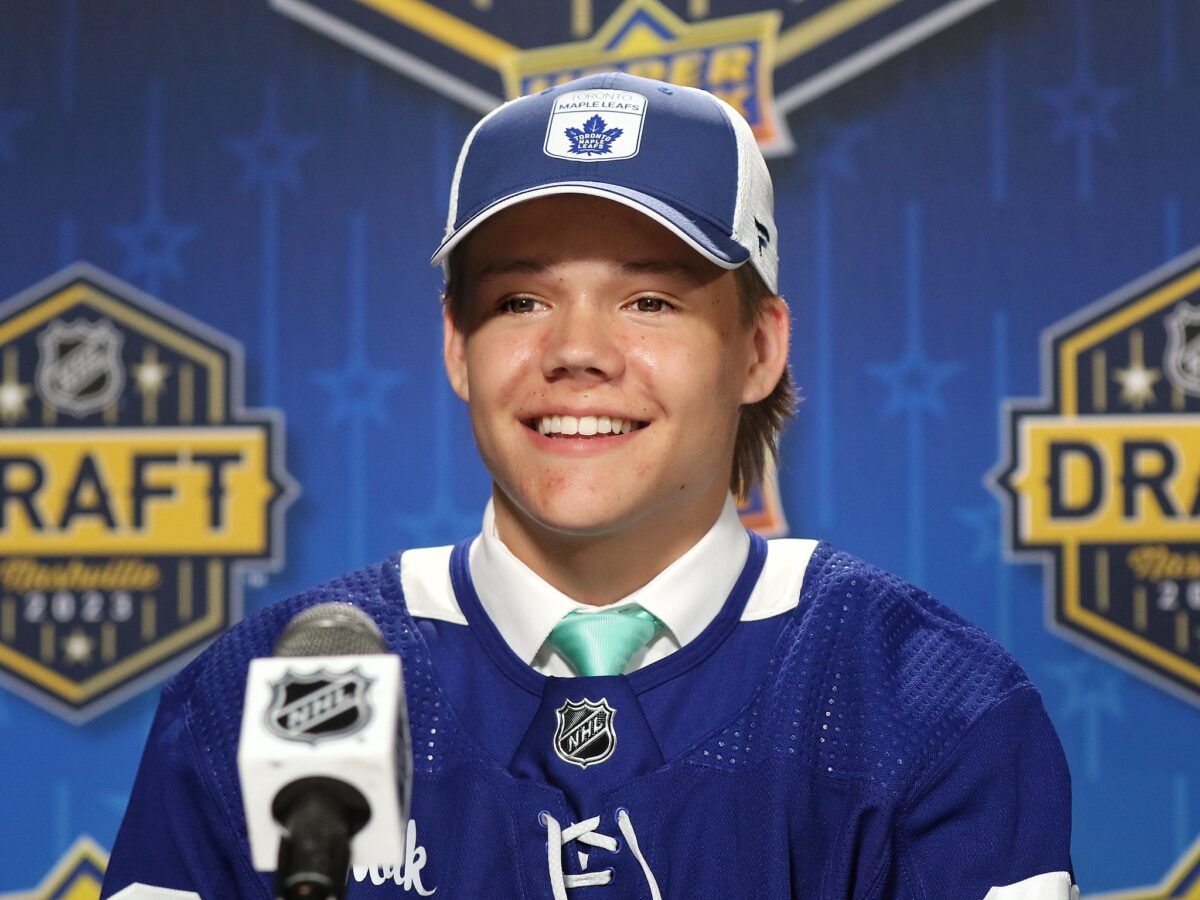The Toronto Maple Leafs are undoubtedly within their Stanley Cup contention window right now. Their forward core is among the most talented in the league, their defence was greatly improved over the offseason, and they’re receiving quality goaltending for the most part from Anthony Stolarz and Joseph Woll. On the flip side to that, their window is shortening season by season, especially after the recent Jake McCabe extension. Their salary cap is tight as it is, and it isn’t going to get any easier from a cap management perspective for the foreseeable future. In addition to that, age is not on their side as a team, and their depleted pipeline won’t be of aid to that.
Salary Cap Situation Will Only Worsen
As abysmal as the Maple Leafs’ current salary cap situation is, it’s likely the best that it’s going to be for a considerable amount of time, barring some unpredictable player movement. For one, now first-line power winger Matthew Knies is going to command a significant raise from his entry-level contract, with projections citing the Juraj Slafkovsky and Alexis Lafrenière contracts as the framework for his next deal. Mitch Marner is in the last year of his contract, and considering that he’s consistently outperformed fellow Maple Leaf winger William Nylander in terms of point production throughout his career, it’s a reasonable assumption to make that Marner’s next deal will surpass his in value. Marner has been subject to scrutiny throughout his career, but the underlying statistics and production speak for themselves and his superstardom is truly worth the price tag.
Beyond those two major contracts, several Maple Leafs players are looking for minor raises from their current contracts. Conor Timmins will command a slight increase from his current $1.1 million average annual value (AAV) arrangement considering his solid play. Connor Dewar should see a slight uptick from the $1.18 million he makes. If he stays, Max Pacioretty will likely get a slight step-up from his sub-$1 million deal, as will Steven Lorentz and Nicholas Robertson. The point is, beyond the two projected mega-contracts, the Maple Leafs have a ton of work to get done for smaller but more numerous raises.
Related: 3 Names Surface in Recent Maple Leafs Trade Talks
The only positive coming after this season in terms of contracts is that ex-captain John Tavares‘ deal is expiring, and he’ll either be moving on to another team that will pay him or take a significant pay decrease to continue playing in Toronto. At the time, his $11 million AAV deal was worth it, but his play has worsened from what it was and his skills have been in decline for a few seasons now. He’s far from a bad player, to be sure, but he is no longer the point-per-game centre he was. If I were general manager (GM) Brad Treliving, I would let Tavares be someone else’s issue.

The 2025-26 NHL salary cap is projected to grow to $92.5 million, a $4.5 million increase from this season’s cap. Without signing any of the players on expiring deals, the Maple Leafs will have about $23.5 million in cap space, according to PuckPedia. Assuming that Knies is considered a part of the core going forward, it’s reasonable to presume that he’ll command upwards of $7 million annually if he continues his breakout. If Treliving prefers Marner over Tavares — which he should — that’s another $11.5 million taken up by a star player. Those two contracts right there already knock the presumed cap space down to $5 million, with only 17 roster spots filled out.
The Maple Leafs will have to penny-pinch heavily; they’ll need to be rid of the bad contracts of players not worth their deals — Ryan Reaves, Matt Benning, David Kampf, and Calle Jarnkrok come to mind, convince the players on expiring deals who want to stay to take a slight pay cut to preserve cap space, and find players who will exceed the value of their contracts in free agency. It’s a recipe for disaster.
The salary cap situation will only continue to worsen after that, as there are several players who should command somewhat significant pay increases after the 2025-26 season as well. Bobby McMann has proven to be worth much more than his $1.35 million AAV value, and goaltender Stolarz has been playing much better hockey than someone who is only getting paid $2.5 million. It’s quite simple — this season presents the best salary cap circumstances the Maple Leafs will have for the foreseeable future.
Aging Curves Not in Toronto’s Favor
As unfortunate a truth as it is, the Maple Leafs fare far worse in terms of average age per player than the average team. With a mean age of 29.08 years old, they are the fourth oldest team in the NHL. Their core forwards aren’t going to slow down anytime soon, with the exception of Tavares, with Matthews, Nylander, and Marner being 27, 28, and 27 years old respectively. Knies is only 22 years old at the moment and should be an integral part of the team moving forward. The rest of their team, though, is on the wrong side of aging curves. In particular, their defensive core borderlines on ancient relative to the rest of the roster. All four Maple Leafs’ defencemen signed through the 2027-28 season — Morgan Rielly, Chris Tanev, Oliver Ekman-Larsson, and now McCabe — are at least 30 years of age, and the group has an average age of 32.
Aging curves are a way to generalize the effectiveness of NHLers at each age, and unfortunately, statistics are a reason for concern in pertinence to the Maple Leafs’ future. Conventionally, NHL defencemen reach their peak from ages 23-26, and gradually drop off in quality of play from then on. On the wrong side of 30, these aging curves are exacerbated even more so when the player in question is over 30 years old. Thankfully, all four defencemen in question are above-average players, but that doesn’t mean they’re immune to their age. There should be noticeable declines in play over the next couple of seasons, especially from Tanev and Ekman-Larsson, the two oldest members of the Toronto blue line.
Predictable Lack of Prospect Depth
As with just about every Cup contender outside of the Dallas Stars and New Jersey Devils, the Maple Leafs’ pipeline is predictably weak — after all, these are the sort of teams who should be trading all of their futures for win-now pieces. Still, the point remains that their prospect depth is middling at best, and they don’t have any projected game-breakers coming up, either.

Easton Cowan is a top-50 prospect in the NHL, but at this point, it’s hard to project him as a bona fide first-line talent. Fraser Minten is their second-best prospect, but he only profiles as a future third-line center. Past those two, there is a steep dropoff and it’s far from a guarantee that any prospect in their current system will see meaningful NHL minutes. There’s no guarantee that there will be any new notable entrants to the prospect pool, either, as it’s likely that Treliving will opt to trade the Maple Leafs’ early draft picks for current NHL talent at or before the trade deadline. Just to be clear, it’s not necessarily an issue for now, but this is a strong contributor as to why their Cup window won’t be extended any further than their current core allows.
How Long Is the Window?
At this point, given the contract circumstances and age curves, it’s reasonable to say that generously, the Maple Leafs have, at maximum, four years to contend for the Stanley Cup. In a more realistic sense, their contention window is at its peak in the next two seasons. Their defence in particular stands out as a potential issue in regards to their core, with all four locked-in defencemen being on the wrong side of 30 already. It isn’t a concern at the moment, but the team’s best forwards, with the exception of Knies, should in theory be on a slight downtrend from now on in terms of effectiveness on the ice. Treliving surely understands that the time is now to win the Stanley Cup, and the window to do so is closing at a rapid rate.
